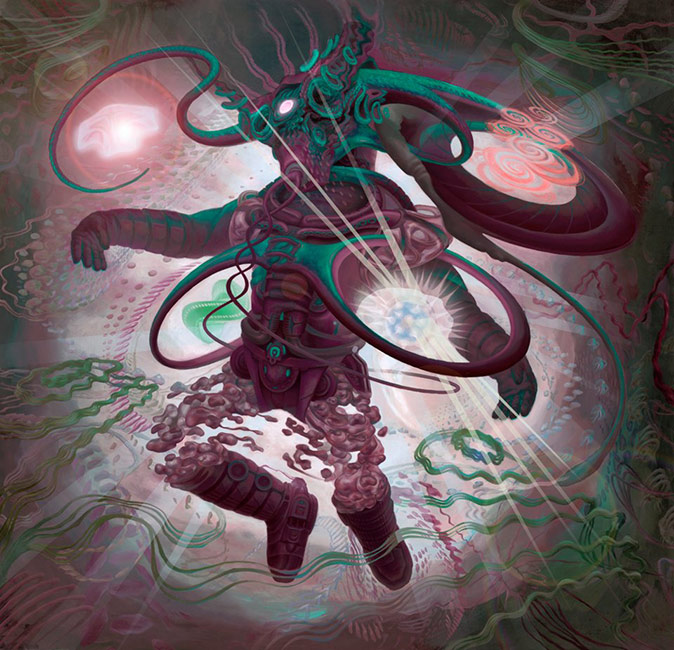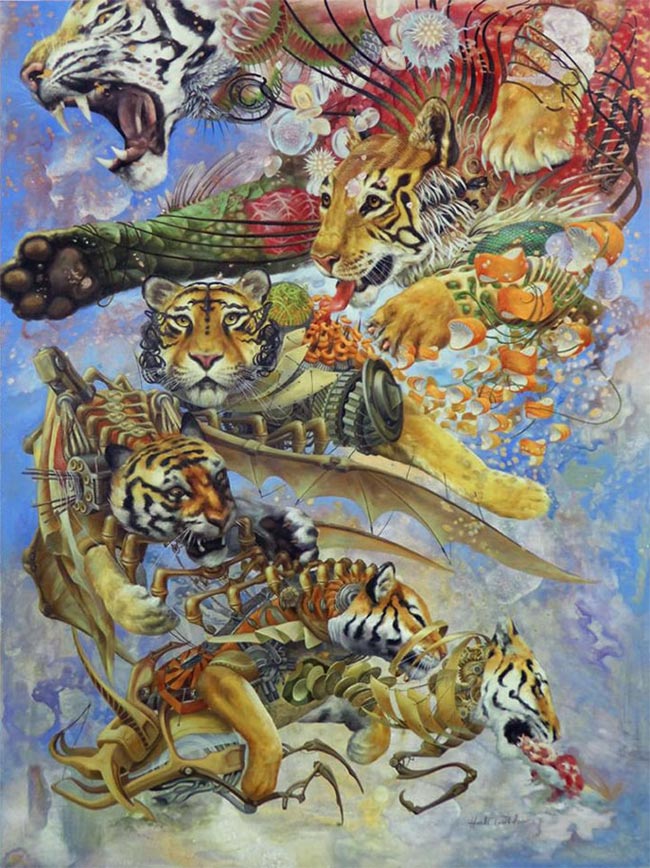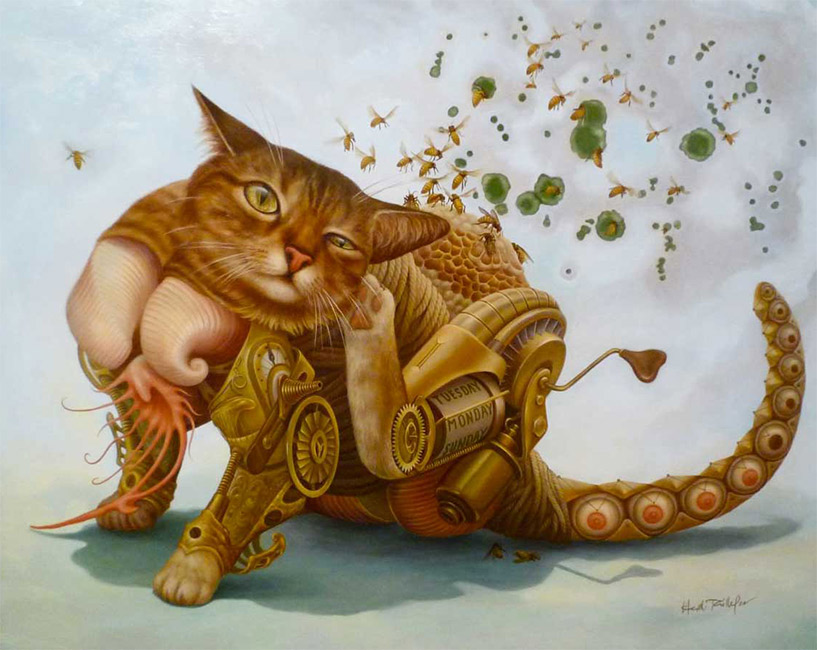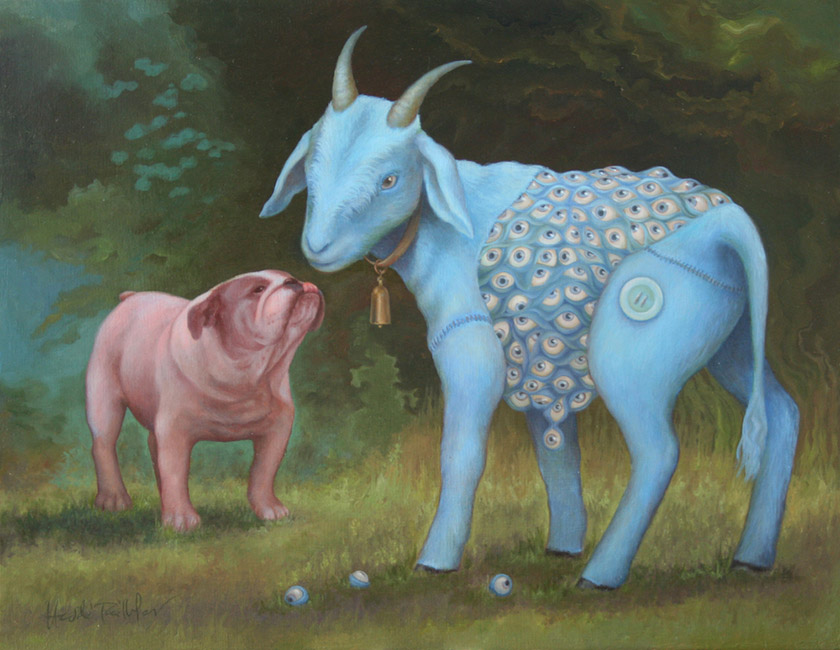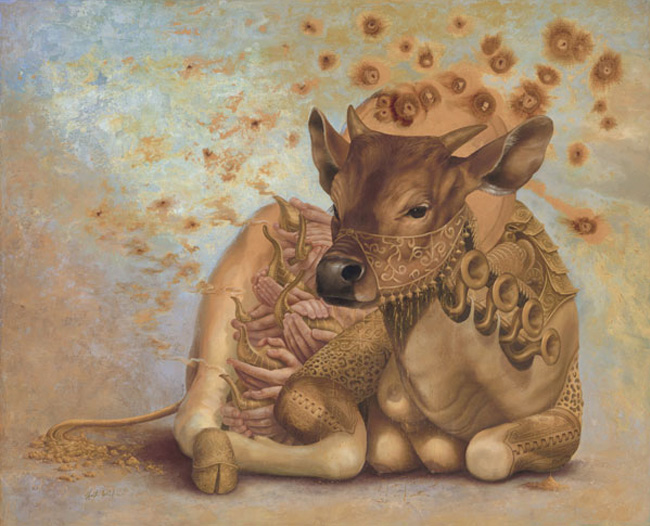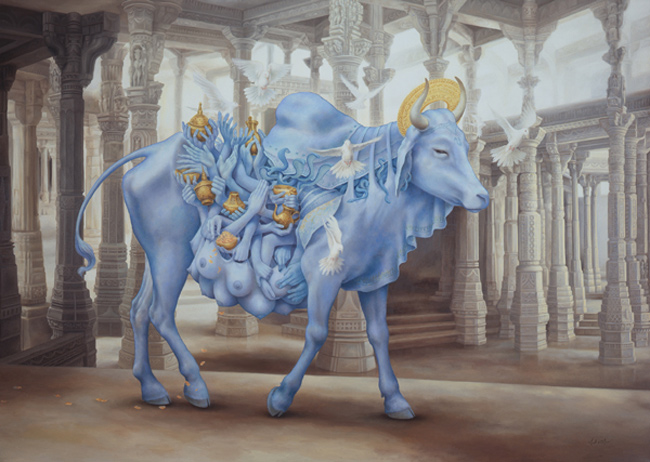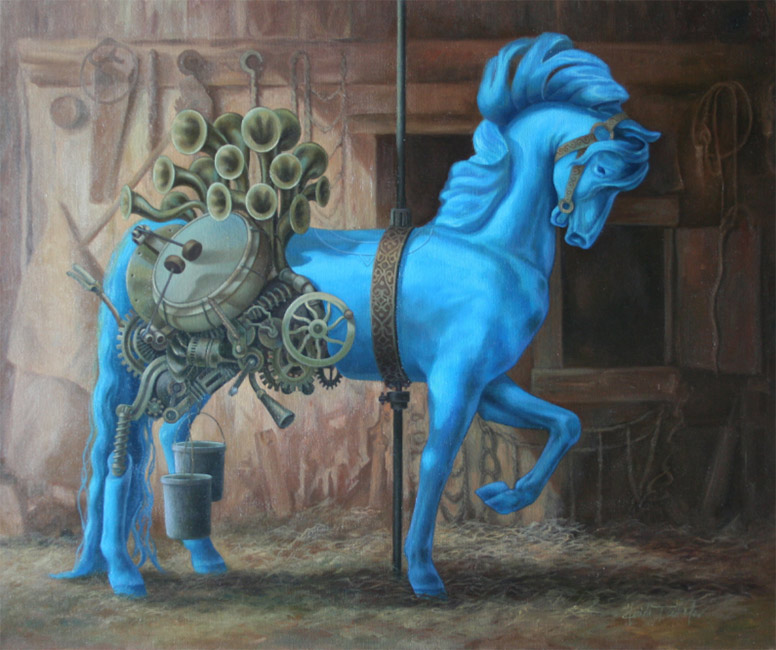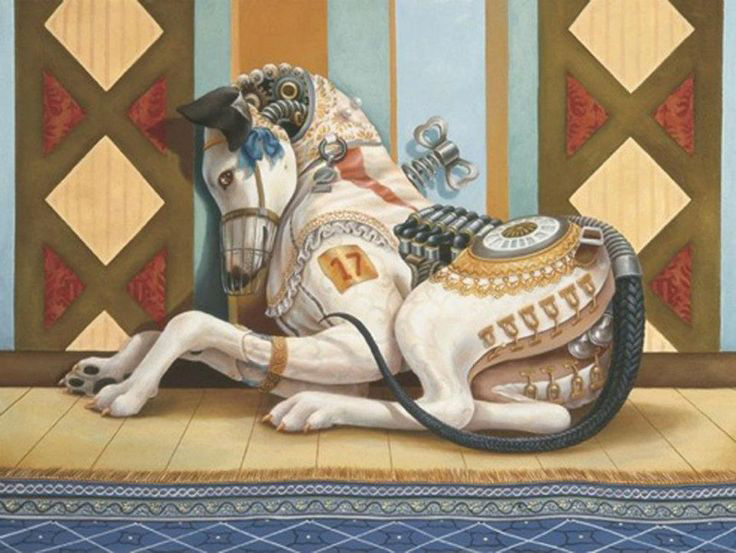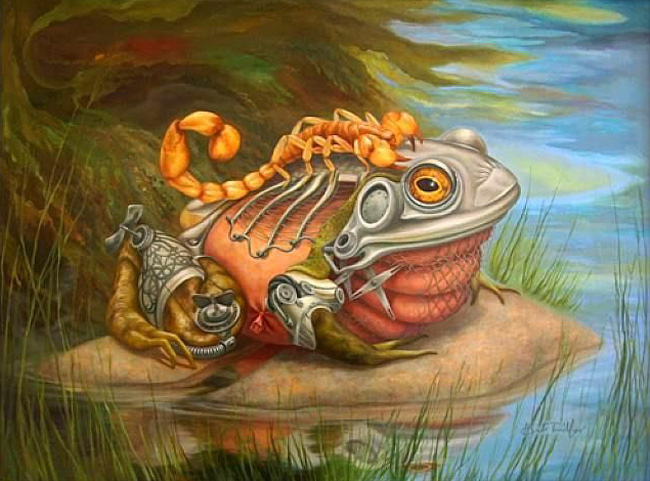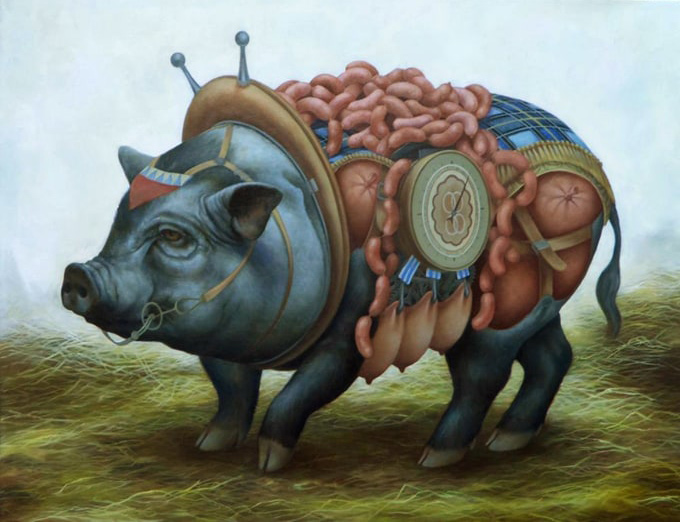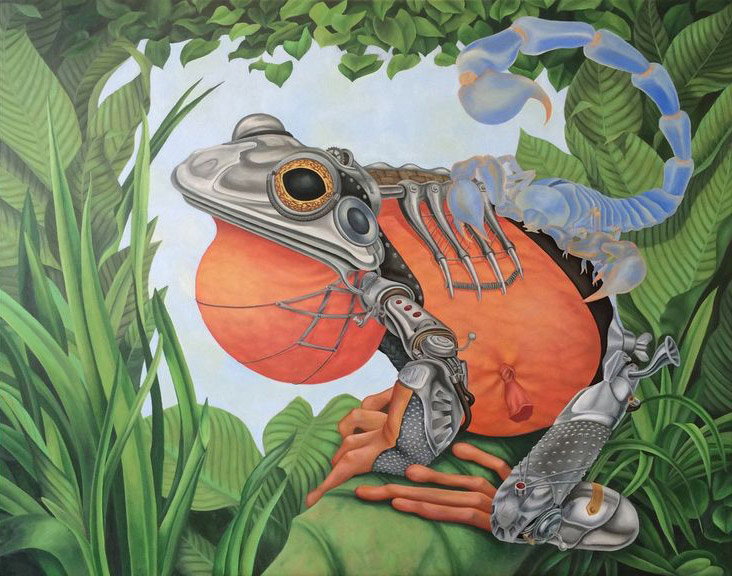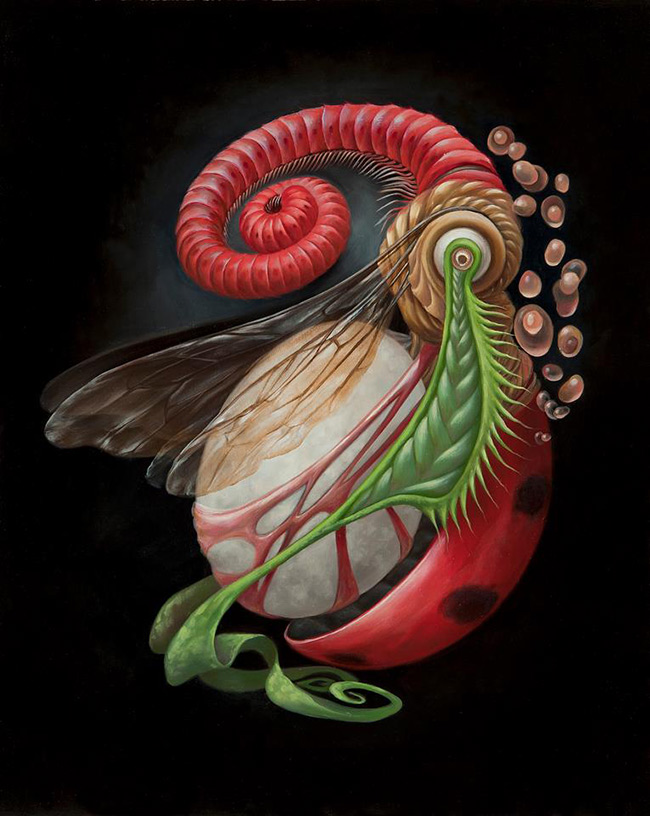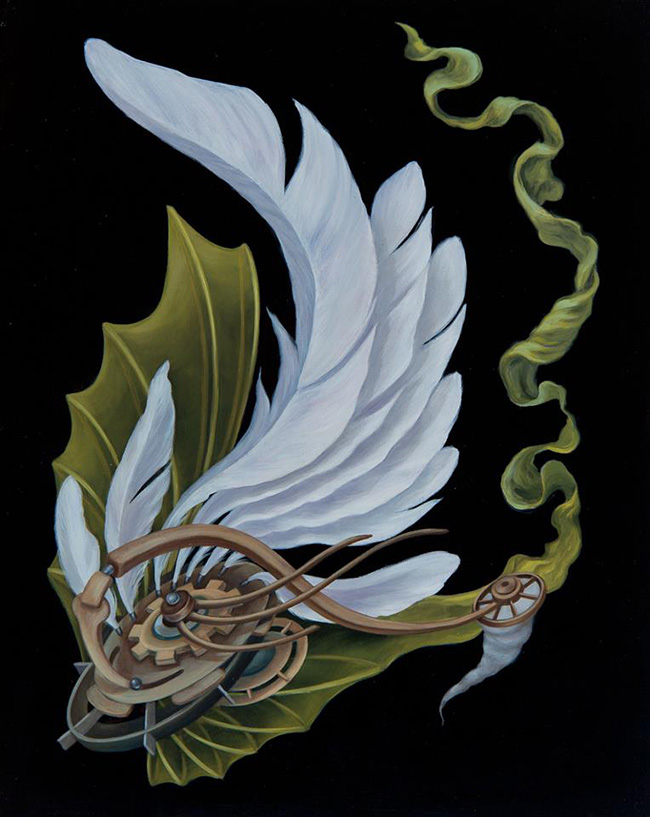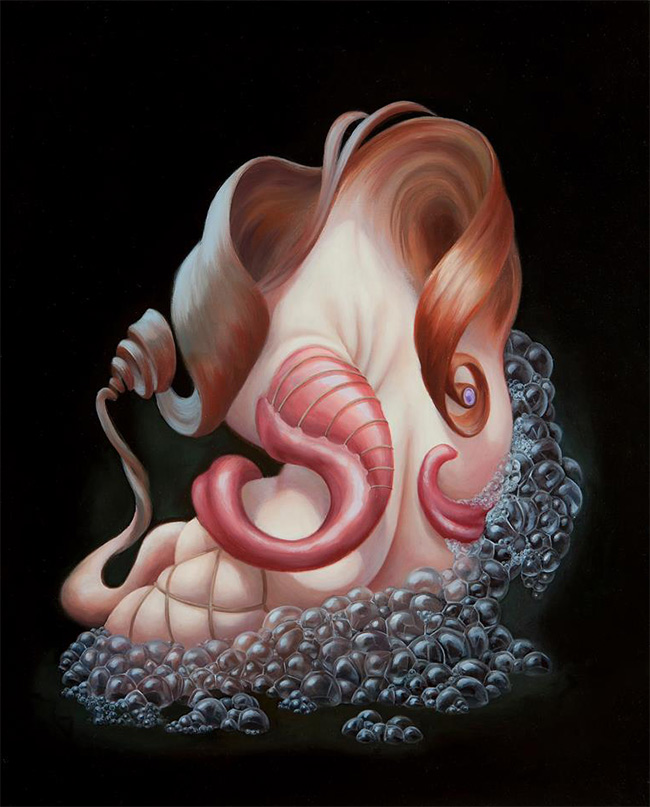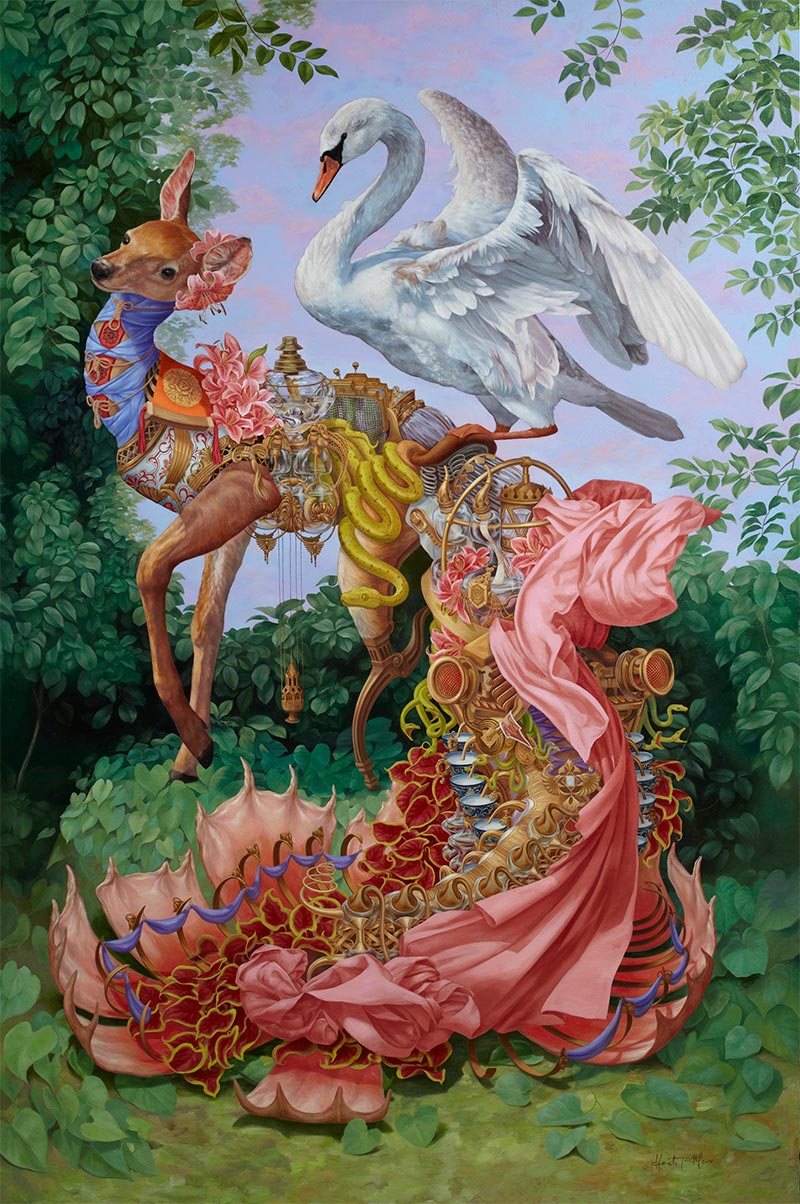Heidi Taillefer’s deeply personal paintings intelligently fuse symbolic and metaphoric references, which come together in a synthesis of perceptions of our past, present and future. Taillefer seeks to explore and provide insights into the human condition, while paying particular attention to humanity’s increasingly complex relationships with technology and the advancement of AI. Her beautifully realised imagery raises important questions for us, as we look to the future and attempt to determine the pros and cons relating to how far we should allow ourselves to integrate with new technologies. In the creation of her art, Taillefer works through her thoughts about what it truly means to be human and we would all do well to keep these notions at the fore as we march forward.
Heidi Taillefer lives and works in Montreal, Quebec. While pursuing a degree in Humanistic studies at McGill University, Heidi studied classics, which continues to inform her work to this day. She has been exhibiting her art for over two decades within both gallery and museum venues. Her work has been collected internationally and resides in prestigious collections including the private collection of film director Morgan Spurlock and the McAllen International Museum of Art and Science.
WOW x WOW is thoroughly delighted to have, not one, but two Taillefer originals in our current ‘Room of a Thousand Doors’ group exhibition. ‘Understanding Leda’ and ‘Bastet’ are both absolutely stunning examples of Heidi’s current work. Read on and get a deeper insight into what goes into the creation of her works, as we find out more about the life and thoughts of this remarkable artist.
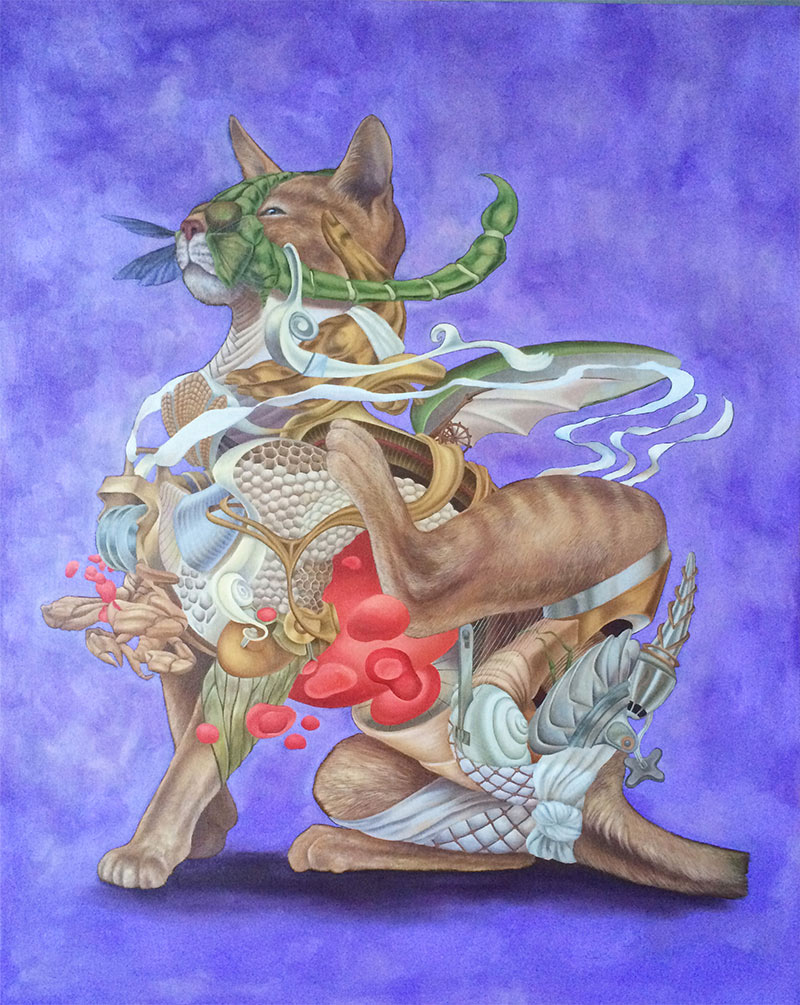
Hey Heidi, thanks for joining us! How have you been since our chat last year? What’s new in your world?
Well, in the last month and a half I got married while travelling in Tanzania and moved from my long cherished neighborhood of Mile End to the suburbs of Beaconsfield, which seems sacrilegious as an artist but the move feels good. I spent 10 years living in a huge studio loft in a commercial building in Mile End, but it’s weird living like that because it is ever so industrial and it’s hard to make a place like that feel like a home, with the dust and the noise and sometimes the smell of the garbage bin in the back entrance of the building. I got used to living in a studio however, and will miss it, but my life has really changed suddenly and I have greater family obligations to consider now too, since we’re not sure if my father is coming down with Alzheimer’s and I may have to take care of him.
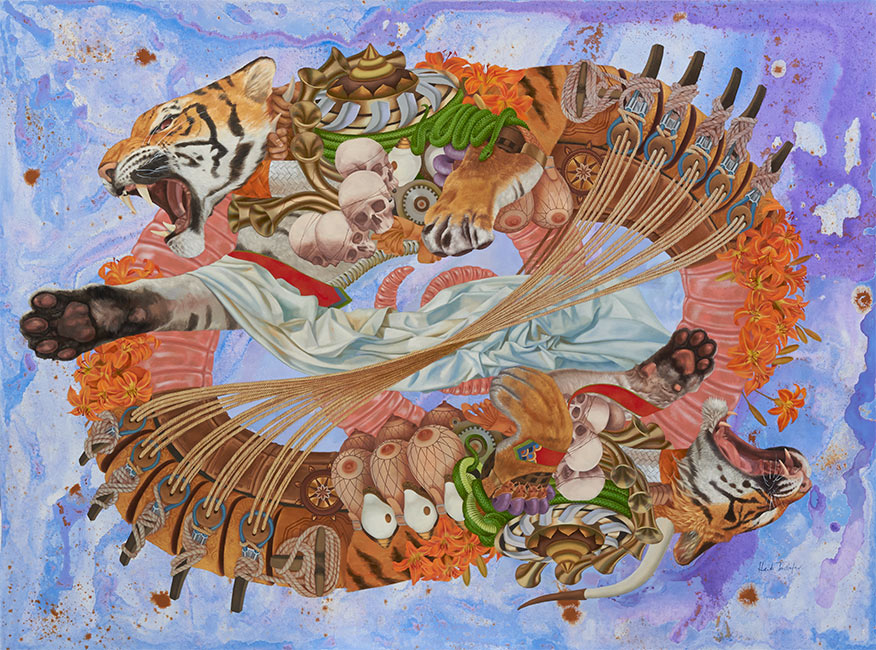
In what ways did your childhood and upbringing affect your relationship with the arts?
My mother is an artist and encouraged us constantly to draw and paint and do artsy little projects. From the time we could hold a crayon we were drawing without coloring books, which she refused to let us have, so as to instil greater creativity and drawing ability. She had art books all around and enrolled us in art classes from an early age, which I continued doing at a very popular local art school in Beaconsfield (where I also grew up) called La Palette. Art was imprinted upon me from the very beginning, and it affected everything from my taste in food to travel destinations and lifestyle choices, etc.
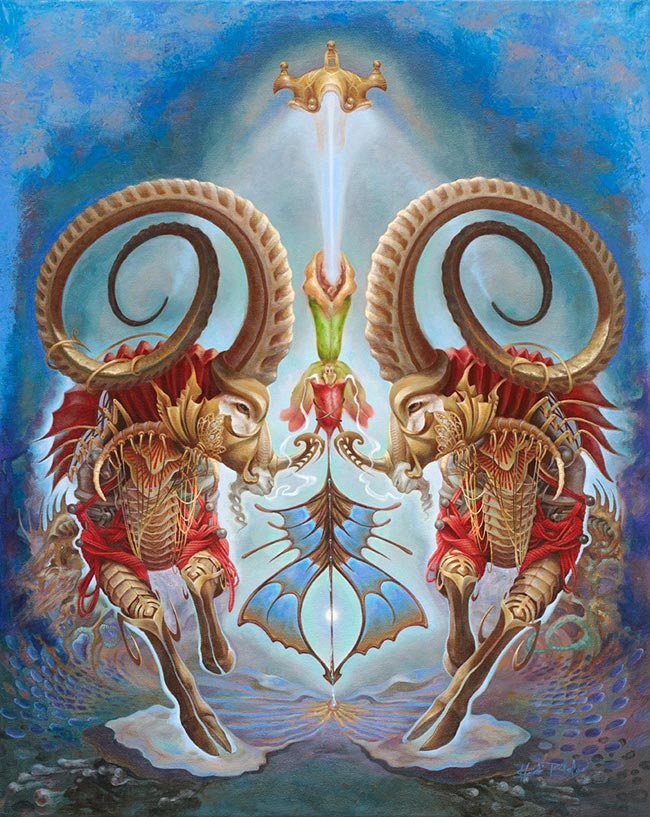
You have a couple of fantastic paintings in our ‘Room of a Thousand Doors’ exhibit. One of those pieces is the elaborate and thought provoking ‘Understanding Leda’. We’d love to hear you talk about the piece, how it came together and the inspiration behind it.
‘Understanding Leda’ came out of a tense but seductive and unrequited romantic dynamic I had with someone a few years back, which never materialized and was almost off limits in a certain sense. The image was conceived spontaneously after finding a beautiful photo of a swan, and I seemed to make immediate artistic associations with this dynamic that was unfolding as I was drawing the animal figure. In the past, I was inspired by events after they had occurred, and sometimes I even felt that an event would come to pass after I had depicted it in a painting. But this time the image progressed simultaneously with the development of this forbidden dynamic. In the painting Leda is depicted as a fawn, to highlight her innocence in the act of seduction which from afar seems bizarre since it’s bestial, what with Zeus transforming himself into an animal in order to mate. We ask ourselves how Leda could allow herself to be so deceived, and my painting reflects an empathetic understanding of this incident, even though it’s impossible to guess upon looking at the image.
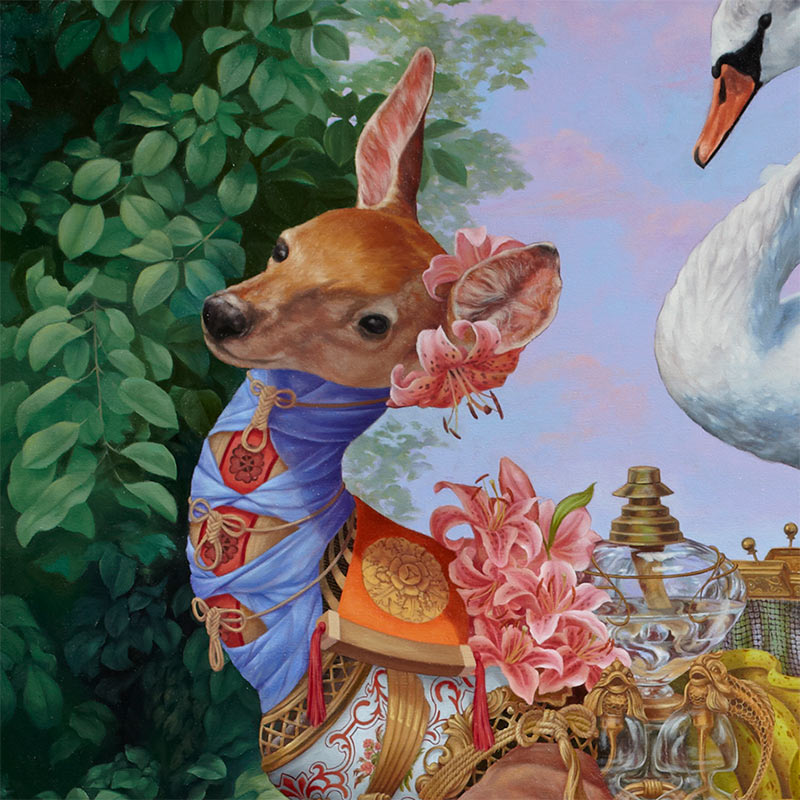
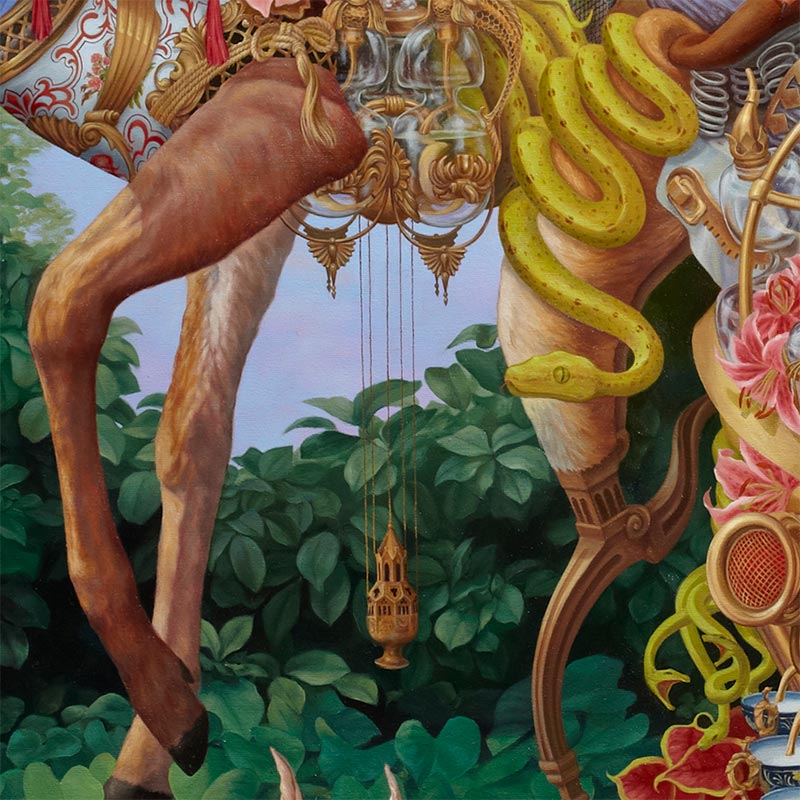
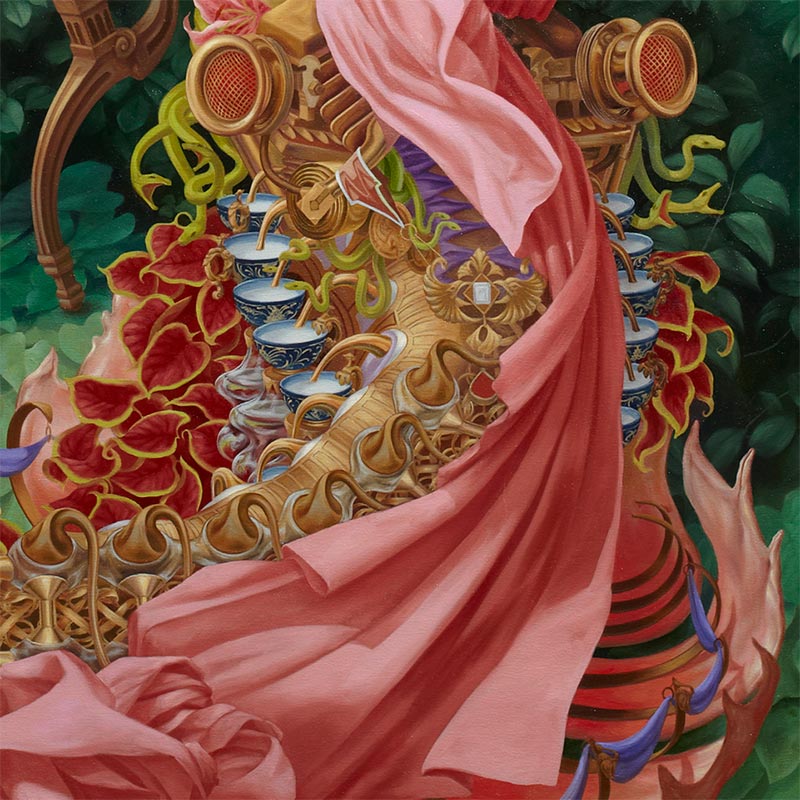
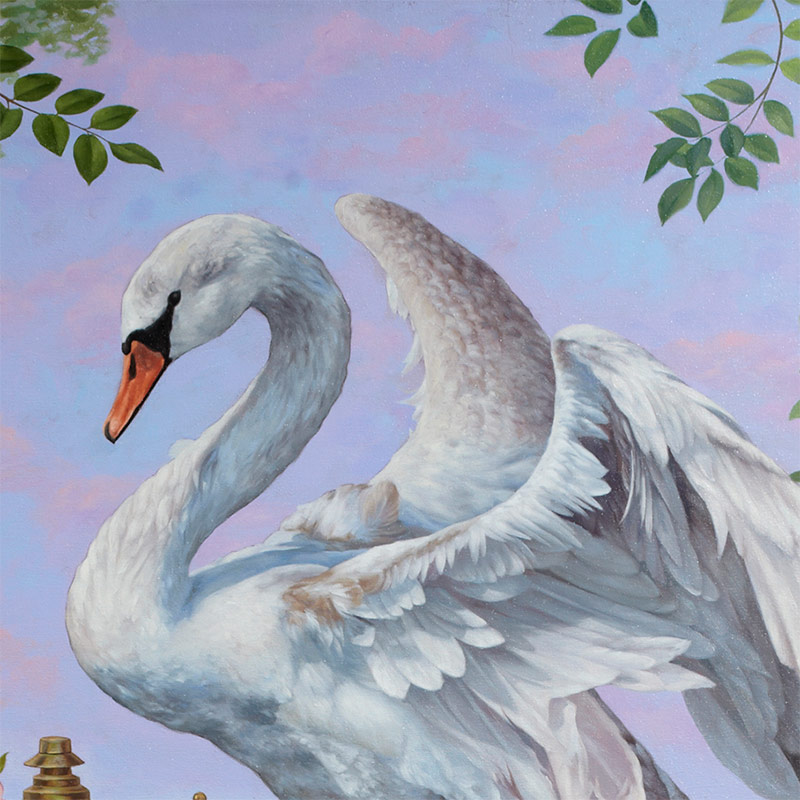
How personal or autobiographical do you allow yourself to get while creating? When you look back at certain pieces or larger collections of your own works, do they remind you of certain events or eras in your life?
I allow myself to get very personal, it’s where my best ideas come from, although I don’t always broadcast the most personal sources of inspiration, since it’s too personal. And I would definitely say that looking back at my work reminds me of certain eras of my life. Way back when I was fashioning my style about 25 years ago and before, it was less personal, but I can still remember exact moments when I was working on this painting or that, and where I was at in my mind’s eye. So, they are like bookmarks that encompass various chapters in my life, which I think I’m very lucky to have.
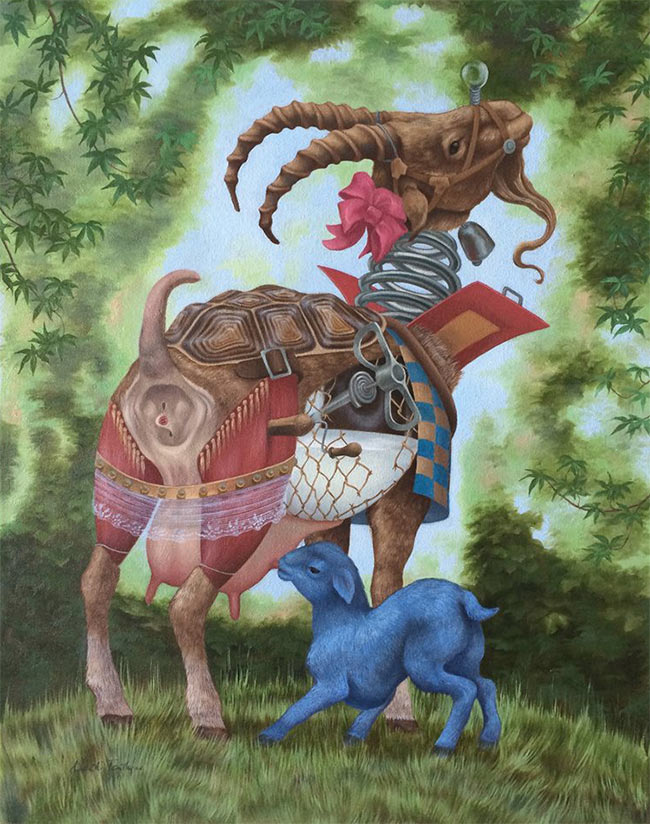
We’d love for you to discuss the ways in which you approach and incorporate the mythological aspects of your imagery in relation to your exploration of the human condition?
As my work went from merely robotic to more symbolic, it left room to play with a wider range of themes. I also learned to weave more personal experiences into my work, and stories found within mythology really ran in parallel with some of what I was experiencing, since they are so universal in touching upon the human condition themselves. Whether I was experiencing love, guilt, vengeance or forgiveness, there always seemed to be a mythological depiction that matched these emotions, so it was a perfect fit. I used to be a kind of luddite when I was much younger, and I was very suspicious of technological advancement when coupled with the frailties of our human nature, and though my opinion of technology has changed, I still see it’s advancement and our merger with it as a potential threat because we are still subject to the ravages of the human condition, which we will never escape.
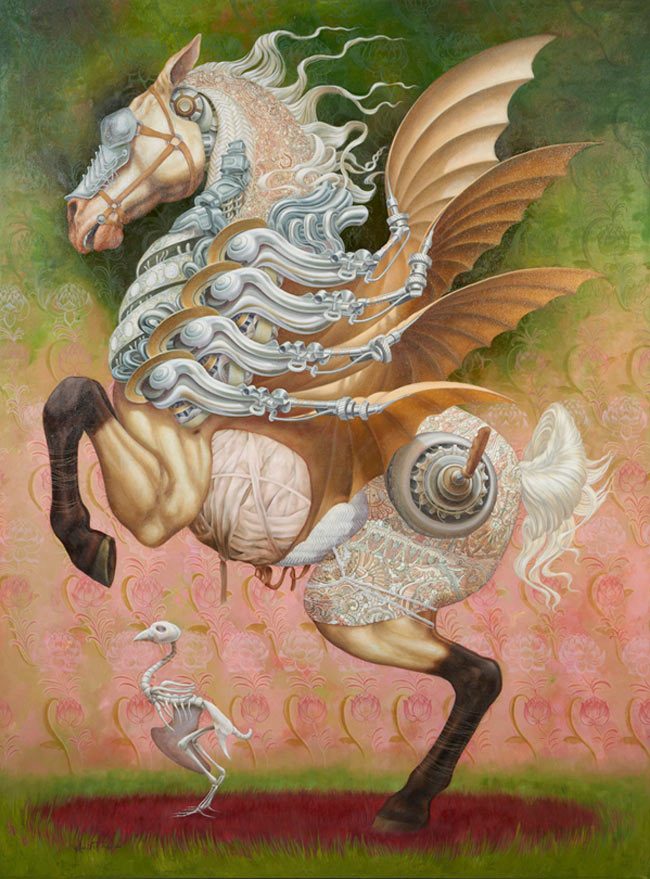
Where does your focus lie when you’re painting?
It’s often very technical, how to balance an image, or which colors to use, what element to depict at what place, but as I get lost in a painting my mind wanders all over the place and it’s like a kind of meditation. I get a sense that the subconscious mind comes closer to the surface and I find myself in a state of reverie, but I’m still focused on the technical challenges, which I know because I find it difficult to concentrate on something else while I’m painting, such as a podcast or radio show.
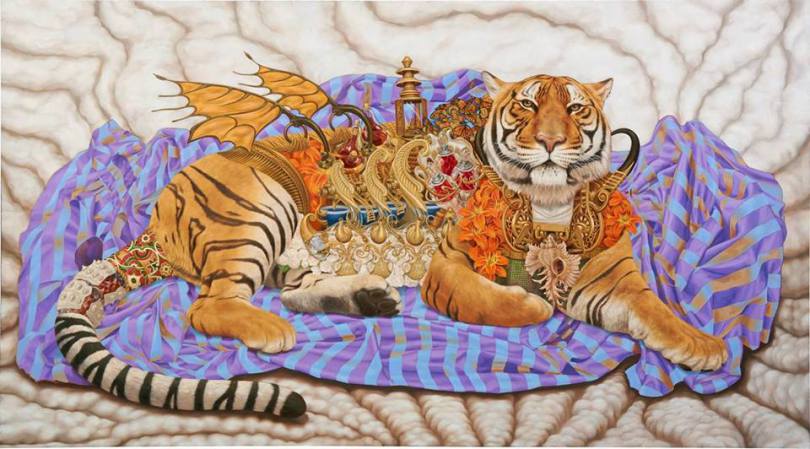
Have there been any occasions where you haven’t always necessarily had a full understanding of the symbols or dialogue that emerge from the narratives within your art? Could you give us an example of an image you painted that ended up revealing something to you after its completion?
There is one painting I produced called ‘Pelican and the Vampire’, which was inspired by a relationship I had with a man who has Asperger’s. In the painting, there is a mulatto woman standing in a clam shell, whose ankles are licked by a devil on a leash. Such relationships are incredibly difficult to navigate, and our own chemistry produced a kind of love-hate dynamic which became very addictive and destructive. At the onset of the painting, I wanted to lash out against him and I depicted myself as a woman standing in a clam shell, and he as a small devilish beast at my feet. As I began painting the image I felt sort of guilty about my intentions, and resisted the desire to avenge myself in a painting. This resistance was extremely difficult at first, and felt like a kind of self-inflicted violation of sorts, but it became so liberating afterwards to hold back any reaction I had to his egregious insult, wondering if he had been aware of what he had done or not, and I felt a kind of unconditional love towards him that I remember had me swoon for a brief time in my studio one night. So the painting which had been meant as a jab turned into one about unconditional love, depicting one of the most unjustly maligned in society as a divine figure looming over her oppressors, rising above them in virtue and strength. That’s not to say that was still me!! But the image turned into a greater social commentary and was in complete opposition to what I had intended for it at the onset. It’s not something I noticed after having completed it with a separate intention, but rather my intention changed throughout the creative process and that’s the closest I can come to saying the image revealed something else to me after its completion.
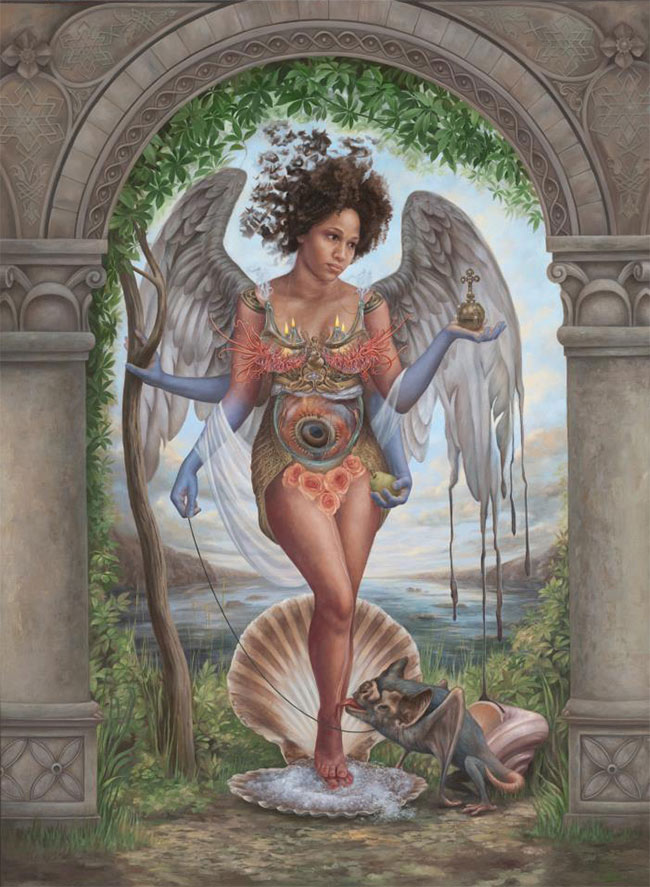
As you are an avid reader, both for pleasure and also creative research, can you give us a little insight about some of the recent topics or books that have provided you with inspiration for your art?
Right now, I’m reading a Wilbur Smith novel about life in South Africa at the turn of the 20th century. It’s a historical fiction, and the third in a series of about eight, but the characters are extremely complex and as loveable as they are despicable, which makes for amazing reading. But the images which are coming to mind are not social, they’re more about wildlife and their fragility in a land where poaching is rampant and so many species are declining an alarming rate. Seventeen years ago, I had portrayed an African elephant in the savannah as a rusted car heap forgotten in the grass, and it’s actually a perfect depiction of what is happening in Tanzania alone to the elephant population, still driven by the illegal ivory trade. So, I feel like I’m interested in painting these animals’ vulnerability, starting with the black rhino.
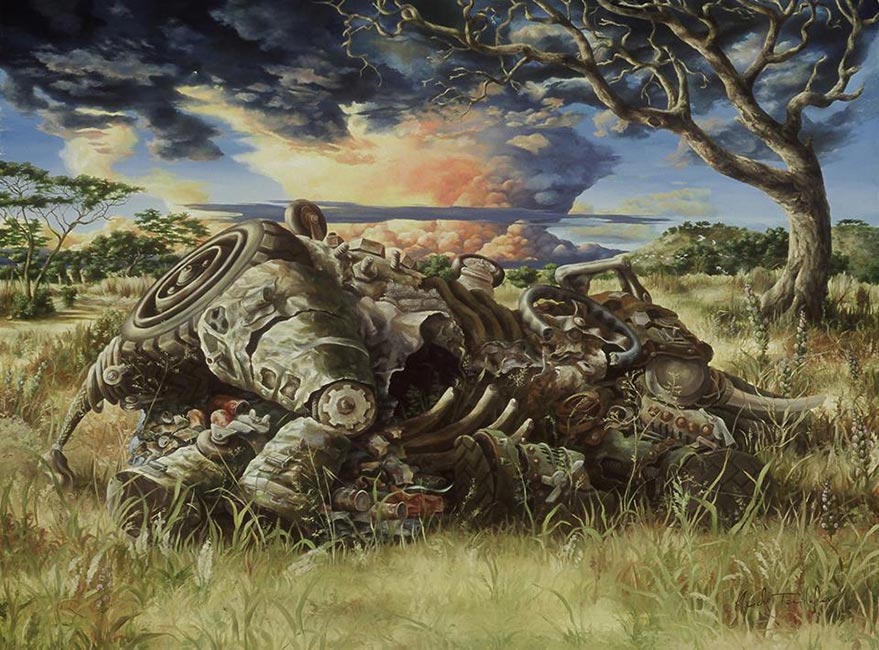
The Surrealists Max Ernst and Girogio de Chirico are two artists you have expressed having an affinity with. Would you be willing to talk a little about the ways you feel your thinking meets with theirs?
I actually never studied art academically and it’s a graduate-of-art-and-media-studies-from-Harvard as well as a-cultural-studies-at-Georgetown-University-professor who saw parallels between my work and Max Ernst and de Chirico, saying I seemed to be channelling the same inspiration as they had but in contemporary terms. With regard to the art of Max Ernst, he worked a great deal with collage, choosing banal images which he set very specifically in combination so as to represent a greater whole, which is what I do, though all the elements I depict are drawn and painted. As for Giorgio de Chirico, he felt his ‘metaphysical painting’ was in keeping with what I was portraying in my own work, where de Chirico had hoped to destabilize the meaning of everyday objects, making them symbols of fear, alienation, or uncertainty. Not to mention the ‘constructed’ appearance of so many of the subjects he portrayed. He had also suggested there were parallels between my work and that of Paul Delvaux, where Delvaux allowed dreams and fantasies underlying the painting to break to the surface. He was concerned with the deeper and hidden elements of the human experience, such as repressed memories or obsessions, and he did so through deconstructing elements, depicting them as skeletons, ruins, or mechanical/architectural structures.
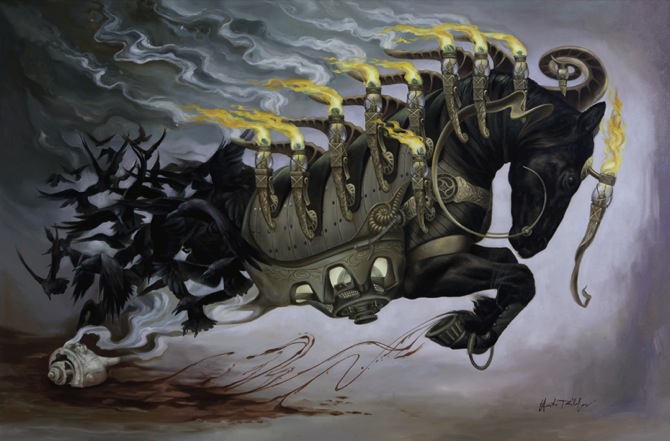
Sticking with the historical inspiration for a moment longer, in what other ways does history play a role in your art making? You can take the interpretation of ‘history’ to refer to both personal and learned instances.
I can only say that my main influences were some of the books on surrealism my mother had lying around, and the era I grew up in (the 80’s), which reflected a certain fascination with science fiction, as depicted in the movies Alien and The Terminator (great movies). I had taken arts and craft lessons as a kid, but I had never studied art academically so any evolution of style came through trial and error, and any art-historical qualities in my work are the result of art that was purely intuitive aside from environmental influences at home and in society. That’s not to say that an education in the classics didn’t help, I had studied ancient Greek mythology and languages at McGill which were great cultural sources of inspiration.
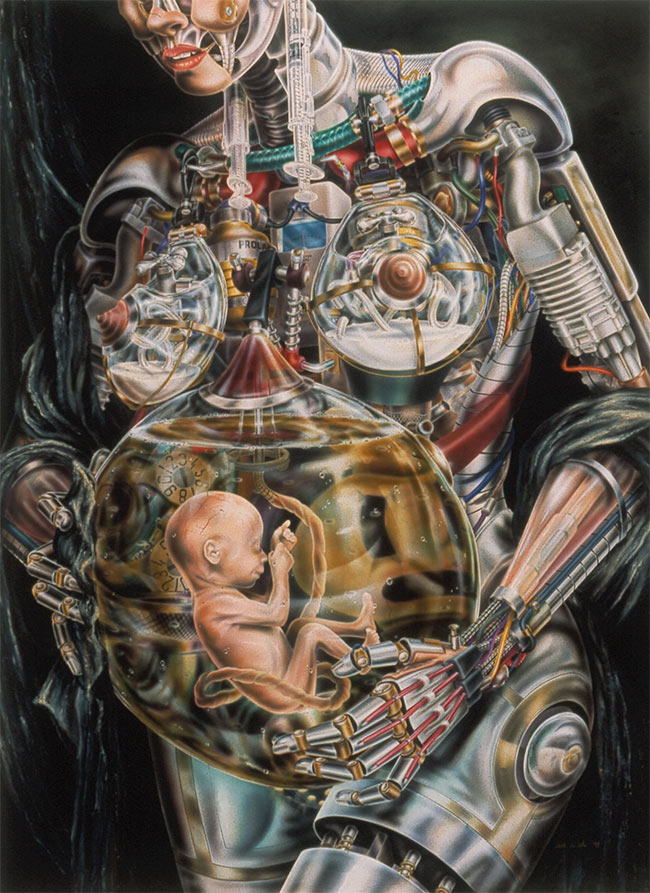
To what extent do you think about the viewer when creating your art and what do you hope that they take away with them after interacting with your imagery? What are your thoughts about the conversation cycle which exists between artist and audience?
I had usually never thought about the viewer when creating my art, preferring to be as honest and as blatant as I wanted and leaving the problem of accepting my work or not up to the audience. But eventually as my work became more symbolic and almost narrative, I really wanted them to understand my meaning behind the work, and even the process I went through in order to convey that meaning. I think it’s important that the audience be at least guided to understand an artist’s work somewhat, which is of course a bit more difficult to explain if it’s abstract, but I like that there is a bit of explanation by the artist or an expert in art. Some artists don’t care how easily it reaches their audience, but now I prefer that there be some mutual understanding about the work. My work was once very much misunderstood, and in a really bad way; I had done a very personal exhibition at the Cirque du Soleil headquarters in Montreal back in 2006 where I posed nude for a photo-roman after I had broken my painting arm and resembled my art, and it was attacked as if it were superficial smut, whereas it was so deep and meaningful, spiritual, and beautiful, and I really wanted to share that. I had an explanation of the show posted on the wall, but people seldom bother to read that, and their own interpretation was so negative it was really disheartening, especially because it was so personal, it really felt like a total rejection.
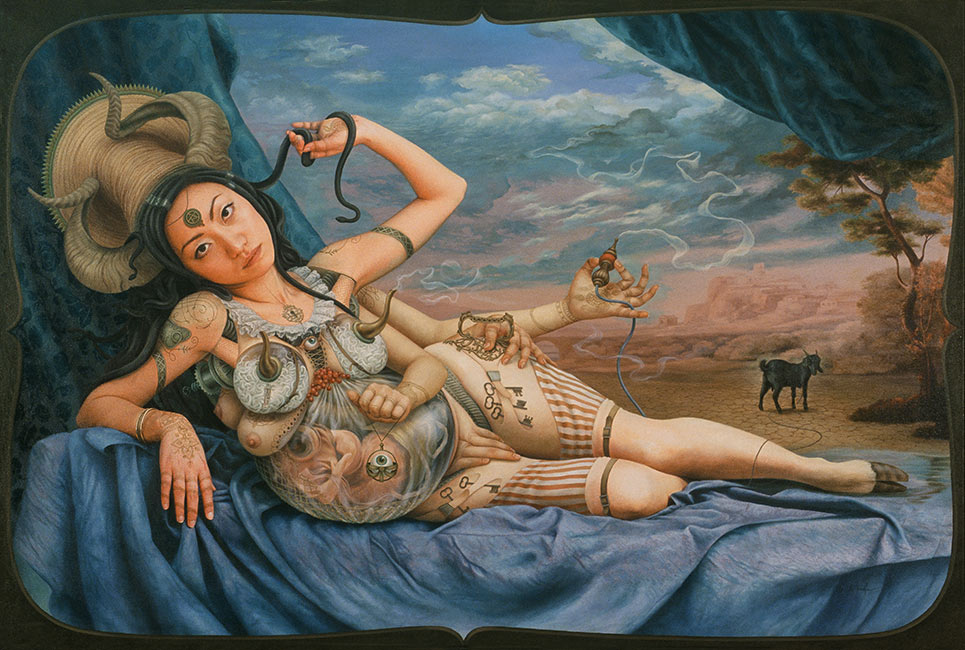
What do you believe your role is as a contemporary artist?
I would say my role is to reflect what is happening around us and maybe even identify what is about to happen. I really believe there will come a point where we will merge increasingly with technology, or AI will evolve alongside of us, and it will open up a whole new discussion as to what it means to be human. Human civilization has made great advances in the last century and we seem to be generally improving and evolving as a species, even if it is in a patchwork formation, and even if there are steps taken backwards (as is happening now with the US), but those advances are not nearly as speedy as is the evolution of technology. It seems obvious to everyone, but I think the distinction of what it truly means to be human will become a major point of contention eventually as technology integrates itself with who we are as animals, who knows when that will happen but it seems inevitable.
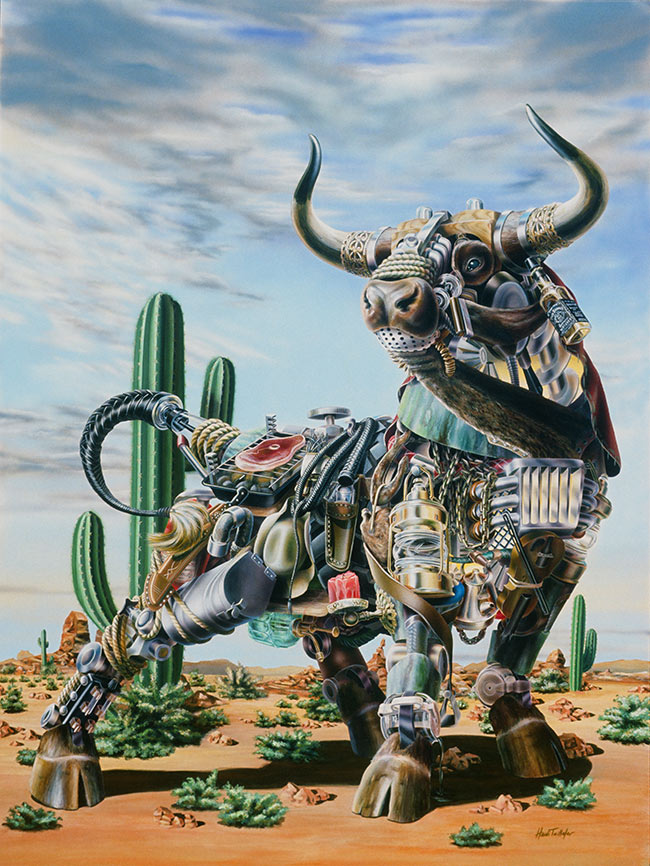
What’s next for Heidi Taillefer?
I think smaller works since my studio has shrunk significantly, and I’m not sure yet what the future holds because I will have heavier family obligations that might force me to slow down artistically, for the near future at least. But something will percolate to the surface and I might illustrate and publish my own children’s book, using old unused illustrated backgrounds I produced about 15 years ago for a book that never got published. But definitely smaller works are in order for the time being.
Heidi Taillefer – Difficult Relationships – Artist Interview – WOW x WOW
